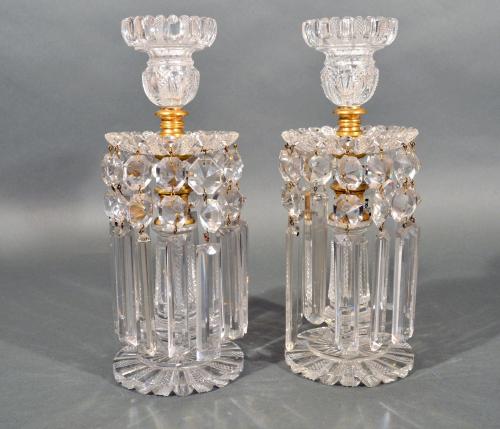

Price on application
This object is eligible for a Certificate of BADA Provenance
The BADA Standard
- Since 1918, BADA has been the leading association for the antiques and fine art trade
- Members are elected for their knowledge, integrity and quality of stock
- Our clients are protected by BADA’s code of conduct
- Our dealers’ membership is reviewed and renewed annually
- Bada.org is a non-profit site: clients deal directly with members and they pay no hidden fees
American Glass Bar Lip Decanters.
American Mold-blown Bar Lip Glass Decanters, Pennsylvania Pattern, Bakewell, Pears & Co. Pittsburgh.
Circa 1860.
Glass.
The decanters are made of a nice heavy glass and were designed to be used without a stopper. The mold impression is strong and very well defined throughout. The glass is clear and brilliant. The base is plain with a nice rough pontil.
Reference: See an online article about this form from the Early American Pattern Glass Society.
http://eapgs.org/bar-lip-decanters.
The Rise and Fall of the American Bar Lip Decanter by Ellen and Bill Morrison.
The 1830s witnessed radical changes in the interior design of bars and saloons. The traditional layout had placed the keeper "behind bars," in a caged area with an opening to the taproom, to protect him and his inventory from unruly customers. However, as bars became more open, the ironwork disappeared and shelves were fitted to a wall behind the tender's back for displaying his range of liquors.
Bars and saloons continued to store large quantities of liquor in barrels, but a means was required to house liquor at the counter in a manner that helped project a suitably refined image. Pottery stoneware jugs were old fashioned and suffered practical disadvantages.
By 1845 new-style city bars had begun to resemble their modern descendants, fitted with elegant trappings and comfortable furniture, intended to attract more discerning customers than old fashioned saloons.
Newspapers began to describe some as "drinking palaces," with long rows of decanters behind the bar. On the other hand, sleazy bars and saloons were referred to as "barrel shops" because they still poured directly from barrels, not decanters.
With most liquor during the period remaining colorless, sophisticated establishments would have required decanters of differing shapes, sizes and designs to assist the bar tender in identifying specific brands. Blown molded and engraved bar lip decanters first appeared between 1830-1840 to meet this specific need.
By the late 1850s the blown decanters were being replaced by pressed versions in numerous patterns and sizes.
The bar lip decanter enjoyed a heyday spanning just 45 years, between circa 1830-75, during which decanters in countless patterns, shapes and sizes, were being manufactured by dozens of American Glass Houses.
Bakewell, Pears & Co. 1808-1882.
http://www.carnegielibrary.org/research/pittsburgh/patentees/bakewell_pears.html.
Benjamin Bakewell, an Englishman, founded the firm that was the best known of all the Pittsburgh glass companies that was also recognized as the oldest glasshouse west of the Allegheny Mountains. The firm underwent nine name changes due to many associations with the Bakewell and Pears families.
Bakewell's first factory was located at the corner of Water and Grant streets in downtown Pittsburgh. Both the factory and warehouse were destroyed in the Great Fire of 1845, but the plant was rebuilt at the same site. The factory was moved in 1854 across the Monongahela River to Bingham Street on Pittsburgh's South Side where it operated until 1882 when Oliver Brothers, wire manufacturers, purchased the site.
Bakewell was known for the quality of its lead or "flint" glass, fine cut and engraved glass, window glass, bottles, lamps, chemical ware and apothecary shop equipment. In its later years the firm produced blown urns and jars, fish bowls, lanterns, smoke bells, and pressed glass patterns that bore names like Argus, Thistle, Prism, Rochelle, Icicle and Saxon.
The firm was one of the first to patent the pressing process and produced fine pressed-wares, pressed furniture knobs and window panes with the Bakewell mark. Bakewell achieved international attention when the principals presented two cut glass vases to General Lafayette during his visit to Pittsburgh in 1825. His letter expressing thanks for the gift is in the Archives of the Historical Society of Western Pennsylvania.
Dimensions
10 3/4 inches highStock number
NY05870The BADA Standard
- Since 1918, BADA has been the leading association for the antiques and fine art trade
- Members are elected for their knowledge, integrity and quality of stock
- Our clients are protected by BADA’s code of conduct
- Our dealers’ membership is reviewed and renewed annually
- Bada.org is a non-profit site: clients deal directly with members and they pay no hidden fees




